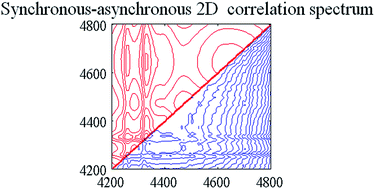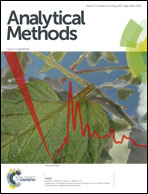Synchronous–asynchronous two-dimensional correlation spectroscopy for the discrimination of adulterated milk
Abstract
A novel approach for discriminant analysis of adulterated milk is proposed using synchronous–asynchronous two-dimensional (2D) correlation spectroscopy and multi-way partial least squares discriminant analysis (NPLS-DA). The NIR transmittance spectra of pure milk and adulterated milk with a level of urea varying from 0.1 to 3 g L−1 were collected at room temperature. The synchronous and asynchronous 2D NIR (4200–4800 cm−1) correlation spectra of all samples were calculated and normalized. A new synchronous–asynchronous 2D correlation matrix was obtained by computing the sum of the upper triangular part of the normalized synchronous matrix and the strictly lower triangular part of the normalized asynchronous matrix. This new matrix preserves information contained and eliminates redundancy in synchronous and asynchronous 2D correlation matrices. Synchronous–asynchronous 2D correlation matrices of all samples were used to construct a discriminant model to classify adulterated milk and pure milk. For comparison, the NPLS-DA models were built based on the normalized synchronous and asynchronous 2D correlation spectra, respectively. Comparison results showed that the NPLS-DA model could provide better results using the synchronous–asynchronous 2D correlation spectra as compared to using synchronous or asynchronous 2D correlation spectra.


 Please wait while we load your content...
Please wait while we load your content...